Synthesis of Anionic Styrene Butadiene Latex Powder and Its Application in Oil Well Cement(Part 2)
2.Results and Discussion
2.1 Characterization
(1).FTIR Analysis
Perform infrared analysis on SBRM, and the infrared spectrum is shown in Figure 2. The absorption peak of SBRM at 3500cm-1 is the stretching vibration absorption peak of carboxyl -OH in the functional monomer MA; 1714cm-1 is the stretching vibration absorption peak of the carboxyl group -C=O- in MA; 1207cm-1 is the characteristic peak of -C-COOH in MA. 1440cm-1 is the absorption peak of -CH2 bending vibration on the molecular chain of polybutadiene; The absorption peaks at 3068cm-1 and 3023cm-1 are stretching vibration peaks with benzene ring CH=CH2; 756cm-1 and 698cm-1 are single substituted benzene rings =CH- out of plane bending vibration absorption peaks; 1600cm-1 and 1490cm-1 are benzene ring CH=CH bending vibration absorption peaks; The absorption peaks at 2930cm-1 and 2840cm-1 correspond to the asymmetric and symmetric stretching vibrations of the C-H bond in the carbon chain, respectively. From this, it can be seen that the infrared spectrum of SBRM contains characteristic absorption peaks of three monomers St, PB, and MA, indicating that the three monomers can be polymerized to synthesize SBRM.
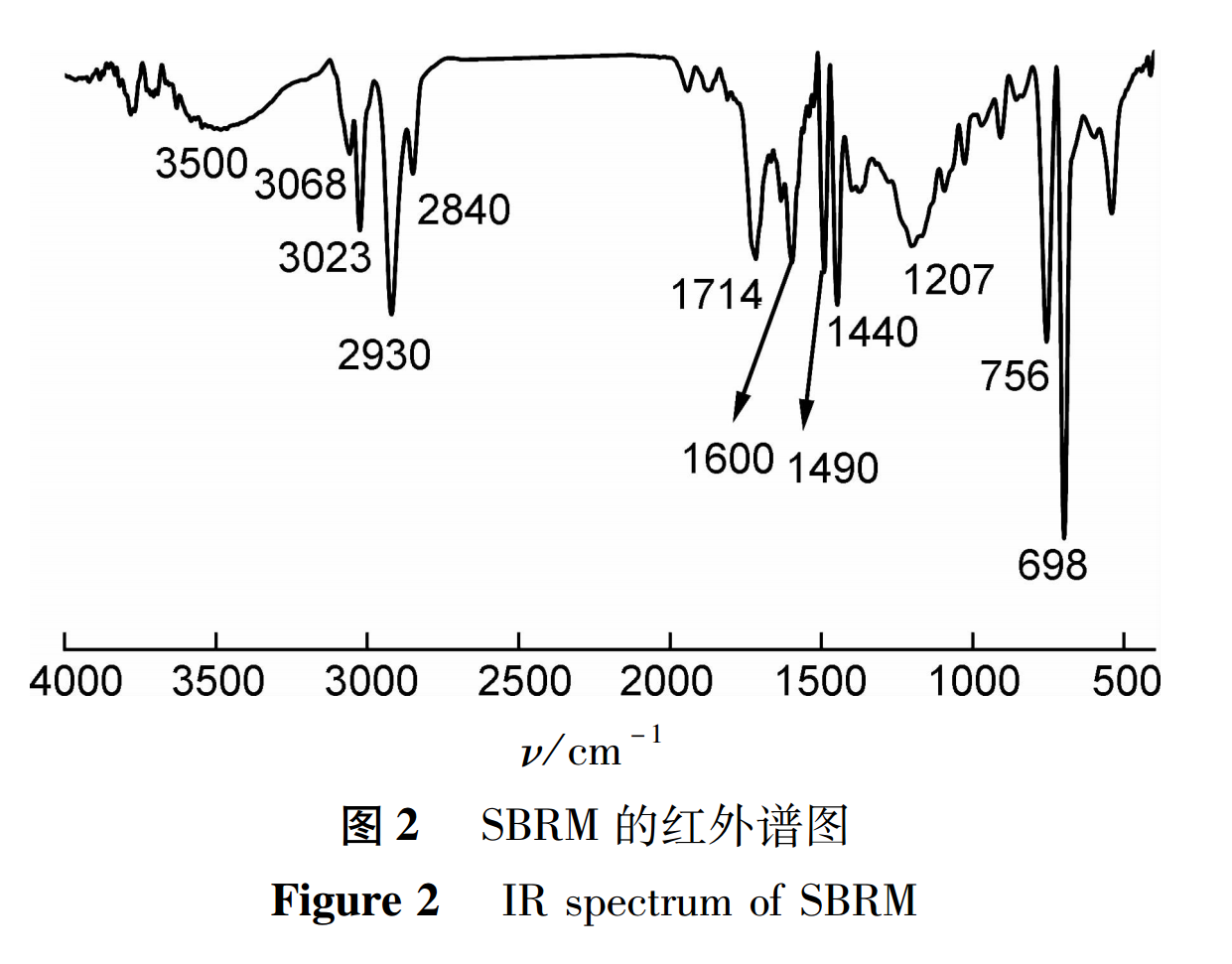
(2) . Nuclear Magnetic Resonance Hydrogen Spectrum Analysis
In order to further determine the molecular structure of SBRM, nuclear magnetic resonance hydrogen spectroscopy testing was conducted, and the results are shown in Figure 3. The characteristic proton absorption peak of methylene (-CH2-) in PB is at chemical shift δ5.02, and δ1.88 is the characteristic proton absorption peak of methylene (-CH-) in PB; δ1.32 is the characteristic proton absorption peak of methylene (-CH2-) in St, δ1.43 is the characteristic proton peak of methylene (-CH-) in St, δ6.85-7.23 and 6.21-6.83 are the peaks of five protons on the benzene ring; δ6.66 is the proton peak of methylene (-CH-) in MA. In summary, infrared spectroscopy and nuclear magnetic resonance hydrogen spectroscopy analysis have shown that the synthesized product is the target product SBRM.

(3). Thermogravimetric Analysis
To evaluate the temperature resistance of SBRM, 5mg of SBRM was weighed for thermal stability analysis, results as shown in Figure 4. Within the temperature range from the beginning of heating up to the decomposition of SBRM, the pyrolysis of SBRM is mainly divided into three stages: the first stage is at 45~220℃, which is mainly the mass loss caused by the evaporation of free water and bound water in the sample after heating up; The thermogravimetric curve of the second stage shows that within the range of 220~375℃, SBRM latex slowly decomposes, with a mass loss rate of about 14%, mainly due to the decomposition of oligomers in SBRM latex; The third stage is at 375~480℃, with a mass loss rate of about 64%, indicating that this temperature is the thermal decomposition temperature of SBRM latex. At this time, the molecular main chain of SBRM latex undergoes fracture decomposition. Thermogravimetric analysis shows that the synthesized SBRM has good thermal stability, and the main chain of SBRM only decomposes when the temperature is above 375℃.
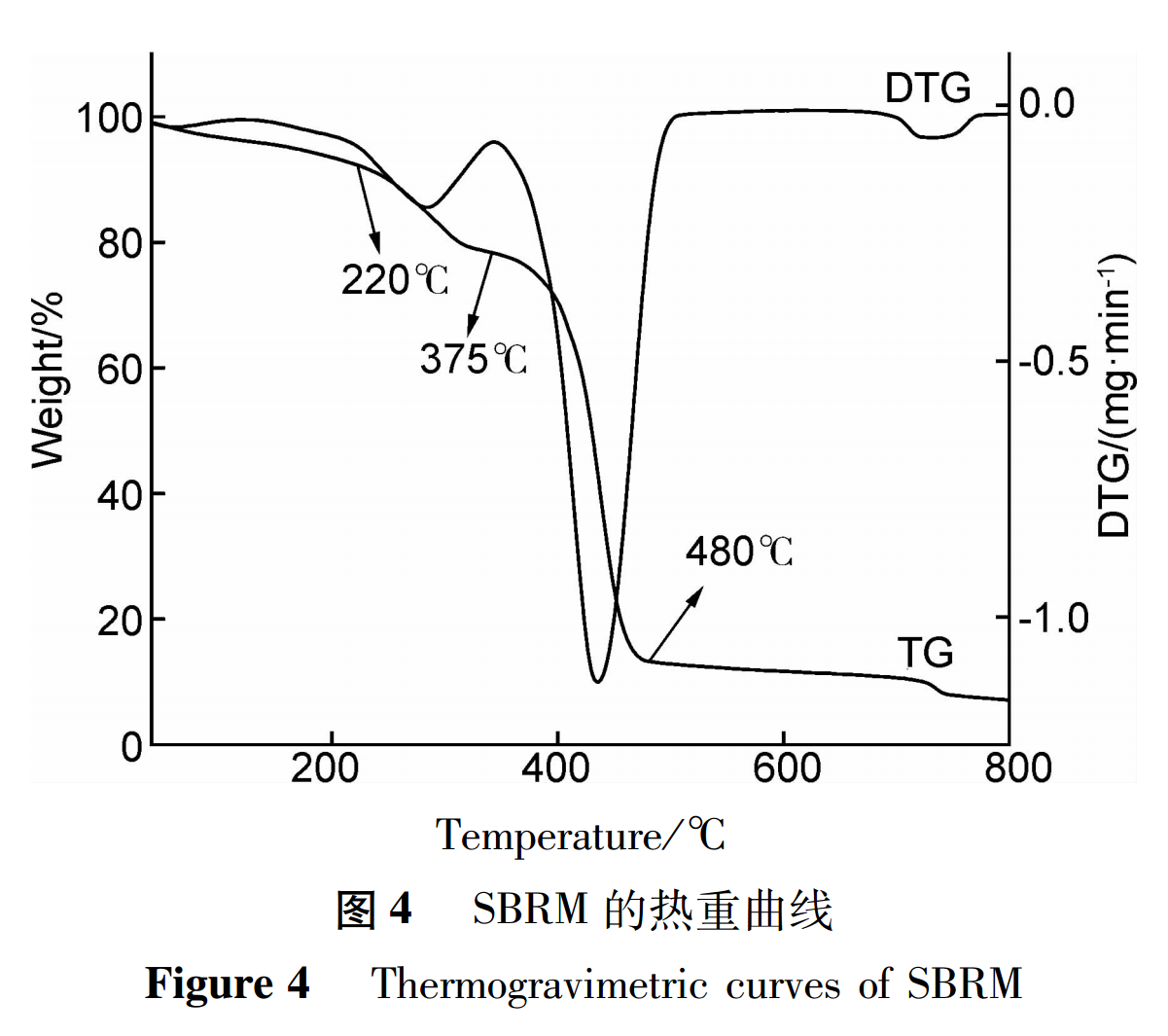
(4). Wettability Analysis
The contact angle test results of SBRM are shown in Figure 5. From Figure 5, it can be seen that the static contact angle of SBRM is 47.1º, indicating that SBRM has a certain degree of water wettability. This is due to the presence of carboxyl groups on the surface of SBRM, which enhances the hydrophilicity of the latex powder. At the same time, due to the addition of surfactants during the SBRM synthesis process, some of the surfactants remain in SBRM, thereby improving its water wetting performance.
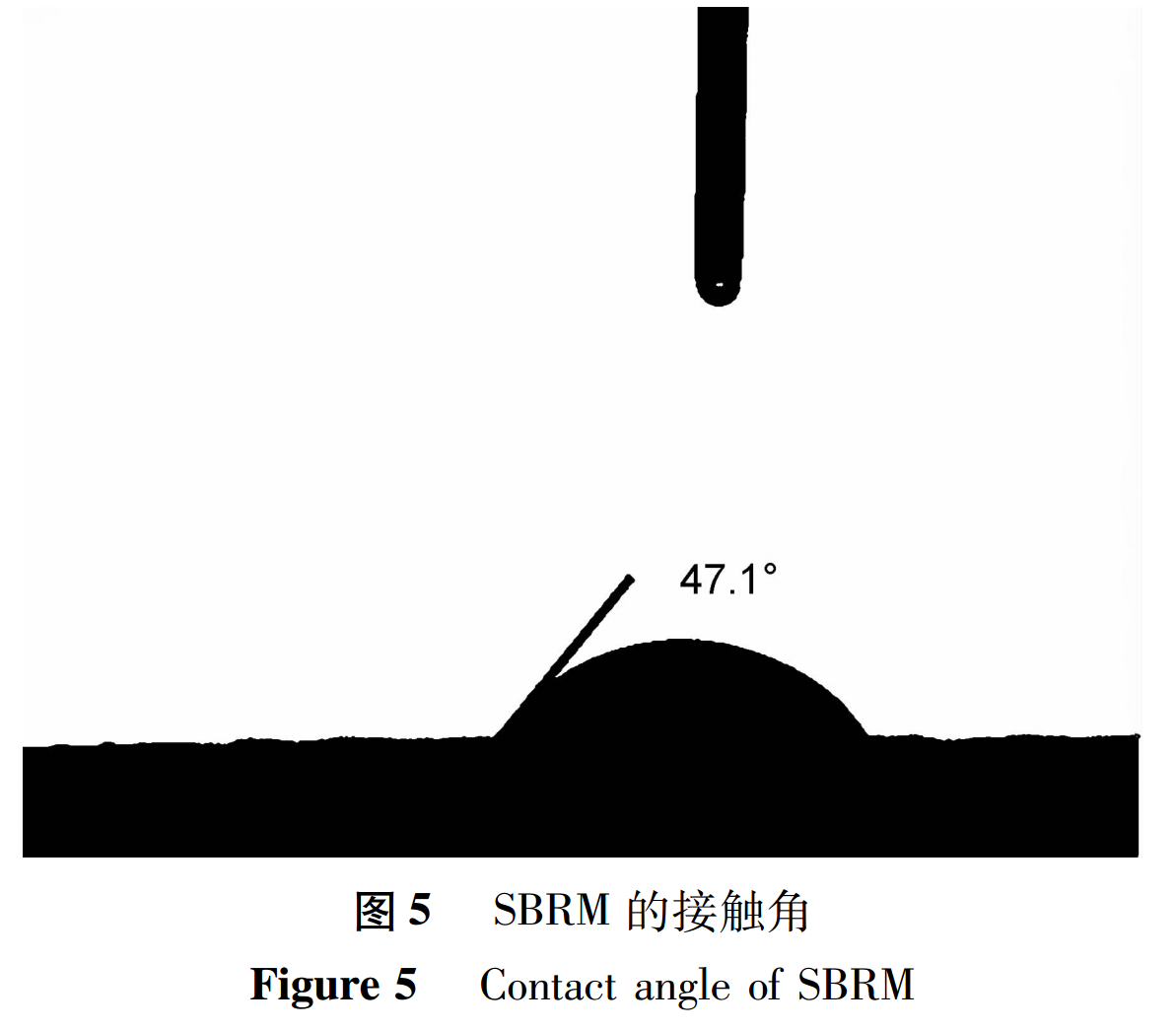
(5). Microscopic Analysis
To clarify the dispersion of SBRM in water, a fluorescence digital microscope was used to observe the dispersion of SBRM, results as shown in Figure 6. SBRM can be uniformly dispersed in water without significant agglomeration, as the carboxyl groups on the surface of SBRM can promote the dispersion of latex powder in water.
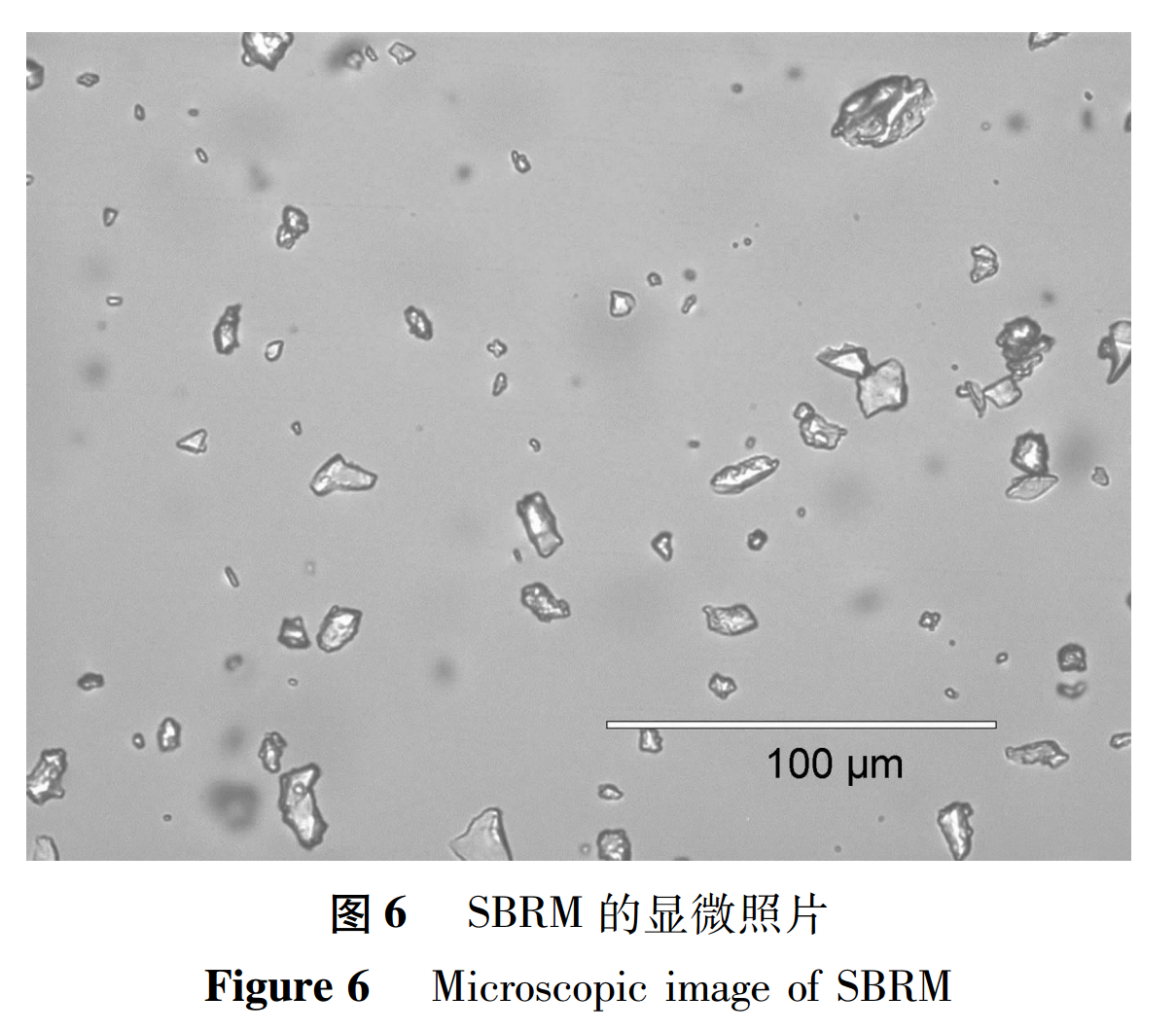
2.2 Performance Analysis
(1). The Effect of SBRM on the Fluidity of Cement Slurry Used in Cementing
During cementing operations, cement slurry with good fluidity can improve pumping efficiency. Therefore, the effect of SBRM on the fluidity of cement slurry is analyzed through cement slurry fluidity testing. Figure 7 shows the changes in fluidity of laboratory made SBRM and commercially available styrene butadiene latex XSBR cement slurry at 90℃. It can be seen that compared to commercially available styrene butadiene latex XSBR, laboratory made SBRM has better fluidity. With the increase of SBRM dosage, the fluidity of cement slurry also increases accordingly. However, when the SBRM dosage increases to 7% (mass fraction, the same below), the fluidity of cement slurry shows a significant decrease. The main reason may be that the latex powder is an organic material, and excessive dosage will affect the compatibility between organic material SBRM and inorganic material cement. From Figure 7, it can be seen that the fluidity of cement slurry is better when the dosage of latex powder is 5%.

(2). The Effect of SBRM on the Compressive Strength of Cement Stone Used in Cementing
By studying the effect of different dosages of SBRM and XSBR on the compressive strength of cement stone, the compressive strength of cement stone was tested under the condition of 90℃ water bath curing for 48 hours, results as shown in Figure 8. From Figure 8, it can be seen that SBRM will reduce the compressive strength of cement stone. At 90℃, the compressive strength of cement paste with SBRM dosage of 3%, 5%, and 7% is reduced by 10.9%, 21.8%, and 31.9% compared to blank cement paste, respectively. Compared with XSBR with the same dosage, although the compressive strength of SBRM cement stone has decreased, it still meets the requirements of cementing construction. From the compressive strength of the cement stone after adding SBRM, it can be seen that when the SBRM dosage is 5%, the compressive strength loss is small, and the fluidity of the cement slurry is good, meeting the requirements of cementing construction.
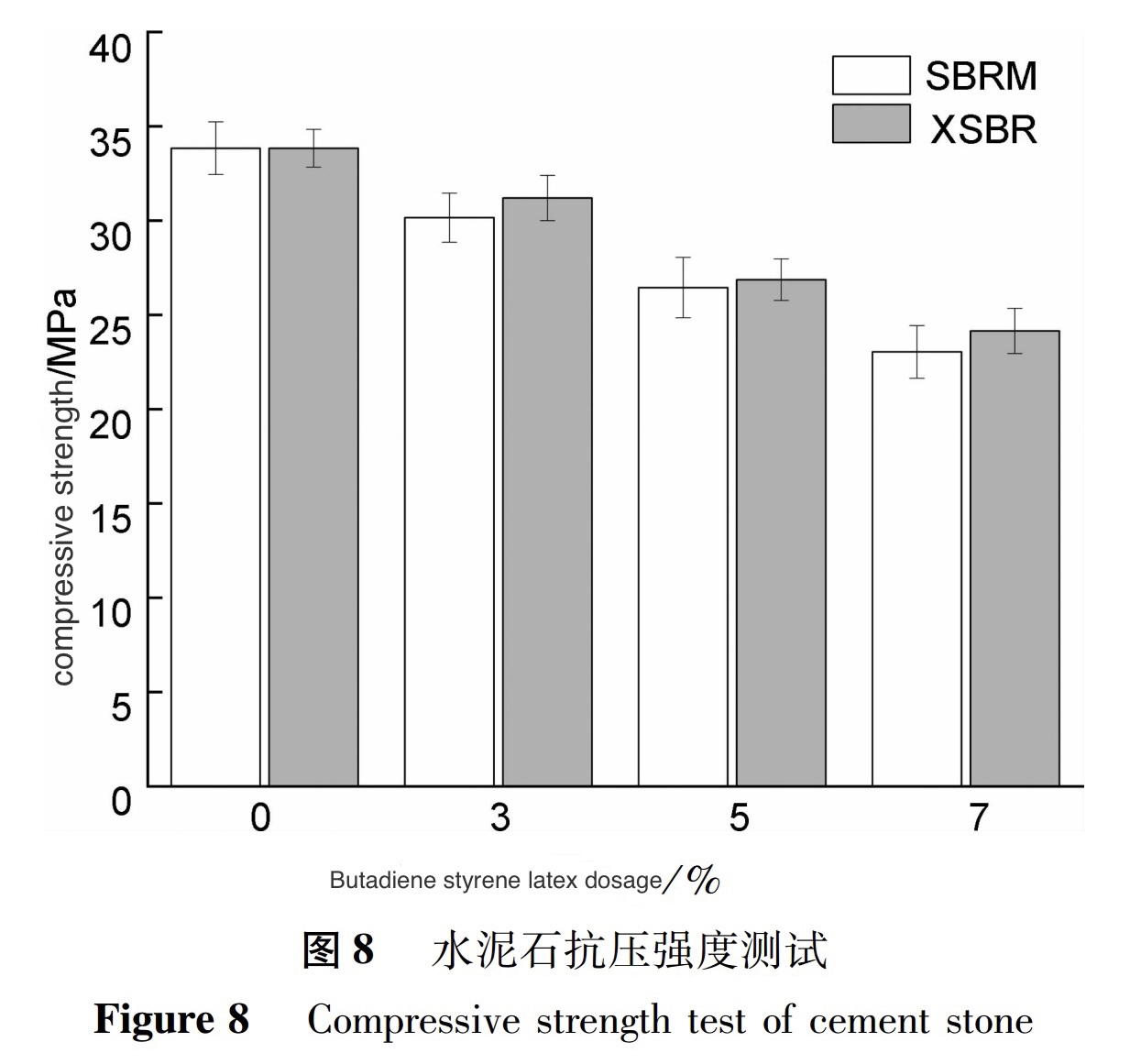
(3). The Effect of SBRM on the Stress-Strain of Cement Stone Used in Cementing
Figure 9 shows the stress-strain curves of blank cement paste, 5% SBRM cement paste, and 5% XSBR cement paste. From Figure 9, it can be seen that SBRM cement stone has a lower corresponding differential stress under the same strain compared to blank cement stone and XSBR cement stone, and SBRM cement stone has stronger deformation ability. The elastic modulus of blank cement stone calculated through triaxial mechanical test results is 7.035GPa, the elastic modulus of cement stone with a 5% addition of XSBR is 5.901GPa, and the elastic modulus of cement stone with a 5% addition of SBRM is 4.230GPa. Compared with blank cement paste and XSBR cement paste, the elastic modulus of SBRM cement paste decreased by 39.8% and 28.3%, respectively, indicating that the cement paste added with SBRM has good elastic properties, preventing and buffering the cracking of the cement sheath under downhole stress, and is conducive to maintain the long-term sealing integrity of the cement sheath.
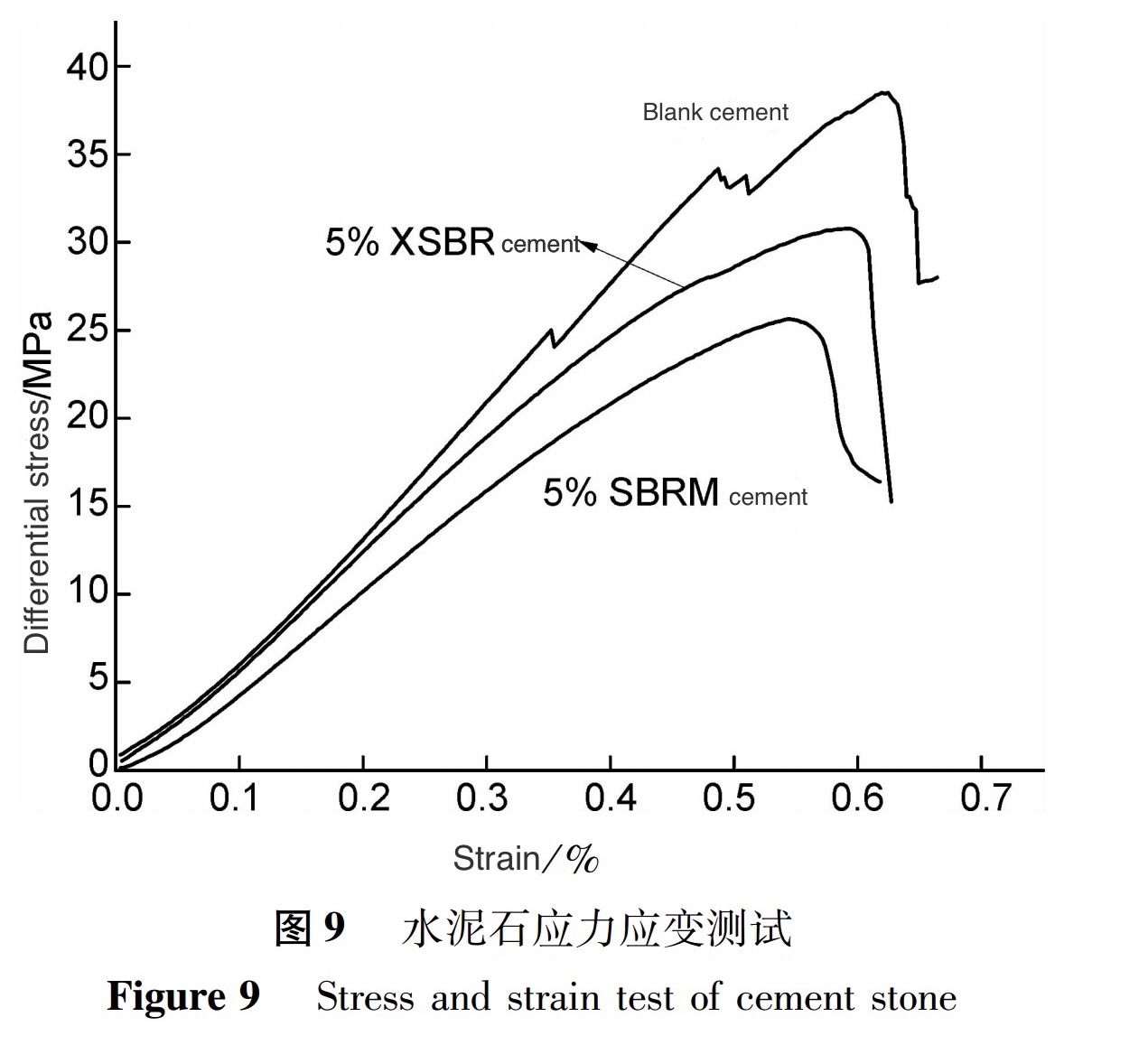
(4). The Effect of SBRM on the Thickening Performance of Cement Slurry
The thickening performance of cement slurry is an important evaluation index for the safety of cementing construction. Figure 10 shows the pressurized thickening curve of cement slurry with a dosage of 6% SBRM at 90℃. From Figure 10, it can be seen that the initial consistency of SBRM cement slurry is low, and the thickening curve trend is stable, basically showing a right angle thickening. There is no phenomenon of "core wrapping" or "bulging", and SBRM cement slurry has good thickening performance, which can meet the requirements of cementing construction operations.
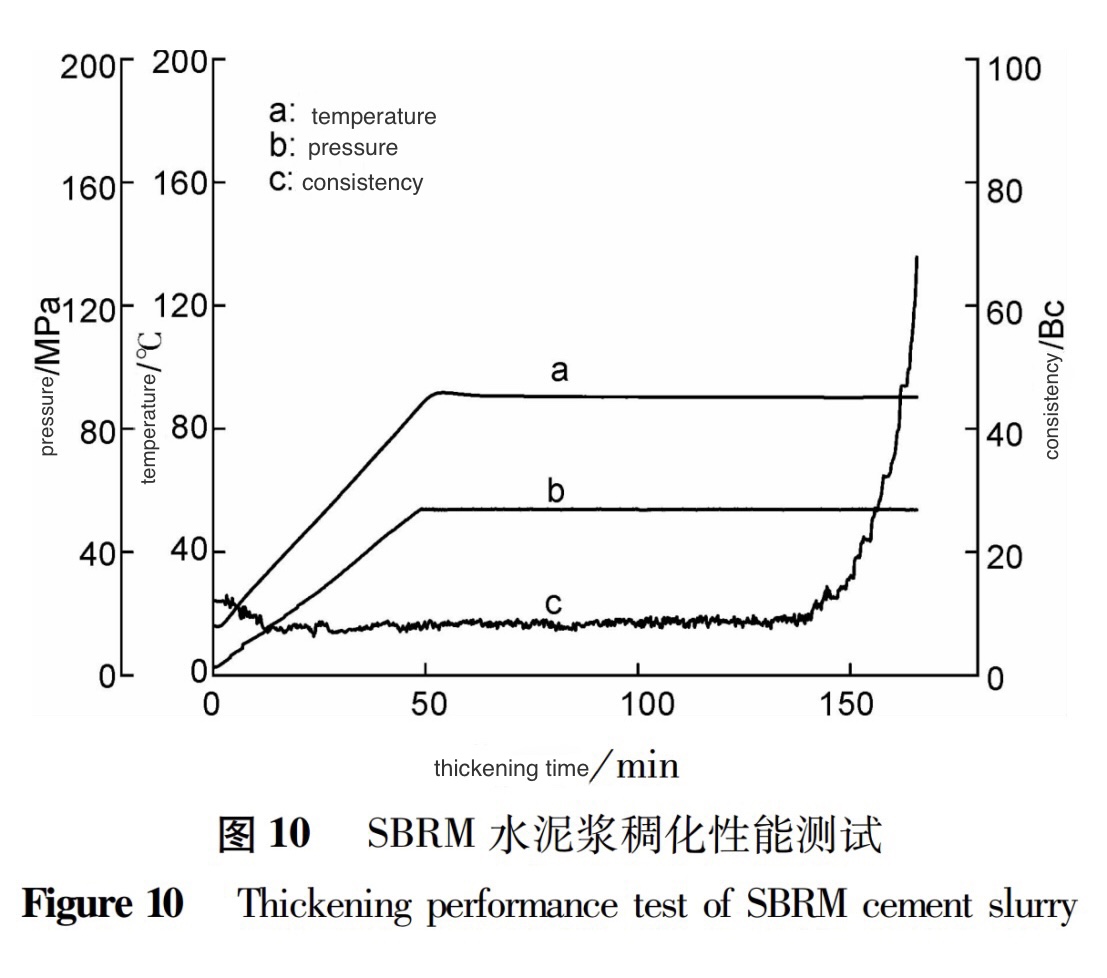
(5). Micromorphology of SBRM Cement Stone
The microstructure of blank cement paste and SBRM cement paste was observed using a scanning electron microscope, results as shown in Figure 11. Compared with the microstructure of the blank cement paste without SBRM, after adding SBRM, the polymer is filled in the cement paste and closely connected to the hydration products, forming a structural deformation center between the cement paste that can constrain the generation and development of microcracks and absorb stress, thereby improving the elastic properties of the cement paste.

3. Conclusion
This article aims to improve the brittleness of cement paste in cementing operations by synthesizing a type of SBRM for cementing.
The infrared spectrum and nuclear magnetic resonance hydrogen spectrum analysis of SBRM indicate that the monomers St, PB, and MA can polymerize to synthesize the target product SBRM;
Through thermogravimetric analysis, wettability analysis, and microscopic observation, it is known that SBRM has good temperature resistance, hydrophilicity, and water dispersibility.
When the dosage of SBRM is not higher than 5%, SBRM can improve the fluidity of cement slurry;
When the dosage of SBRM is 5%, SBRM can improve the elasticity of cement paste under the condition that the compressive strength loss meets the requirements, and SBRM cement slurry has good thickening performance.
The SBRM synthesized in this study has good application prospects in oil and gas well cementing engineering.
